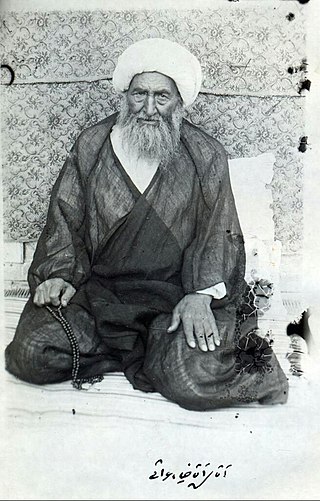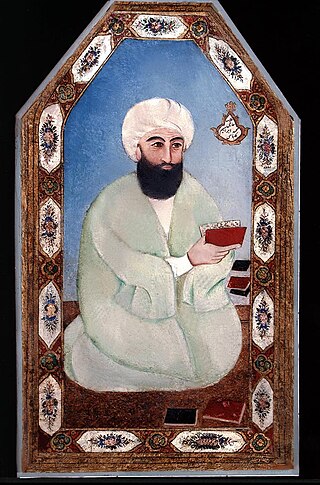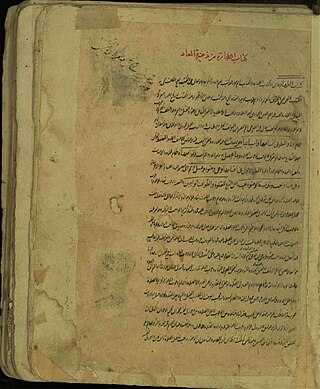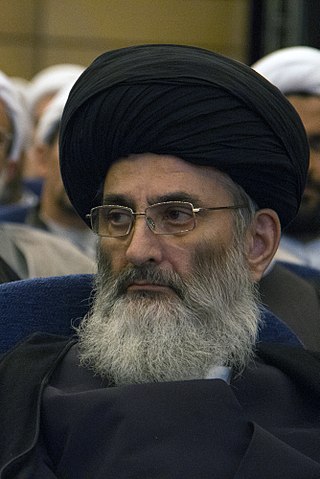
Mahdism in the Twelver branch of Shia Islam, derived from the belief in the reappearance of the Twelfth Shiite Imam, Muhammad al-Mahdi, as the savior of the apocalypse for the salvation of human beings and the establishment of peace and justice. Mahdism is a kind of messianism. From this perspective, it is believed that Jesus Christ and Khidr are still alive and will emerge with Muhammad al-Mahdi in order to fulfil their mission of bringing peace and justice to the world.

Lotfollah Safi Golpaygani was an Iranian Grand Ayatollah. He was at one point the most senior Twelver Shia scholar (Marja') in Iran until his death. He resided in Qom and taught Islam in the Qom Seminary.

In Islamic theology, taʿṭīl means "divesting" God of His attributes. The word literally means to suspend and stop the work and refers to a form of apophatic theology which is said because God bears no resemblance to his creatures and because the concepts available to man are limited and depends on his perceptions of his surroundings, so he has no choice but to remain silent about the divine attributes and suffice with the explanations given in the Quran and hadiths. Taʿṭīl is the polar opposite of tashbīh, the ascription to God of physical characteristics or human attributes such as emotion. Both taʿṭīl and tashbīh are considered sins or heresies in mainstream Islam.
Grand Ayatollah Sayyid Taqi Tabatabaei Qomi was an Iranian Shia marja'. He, along with Ali al-Sistani, and Ali Falsafi, were among the only three people to receive a written statement declaring their ijtihad by grand Ayatollah Abu al-Qasim al-Khoei.

Zia'eddin Araghi also known as Agha Zia'eddin Araghi was an eminent Shia jurist, Usuli and Mujtahid during the flourishing the Usul Fiqh in Ja'fari school in Shia after Muhammad Baqir Behbahani.
Mohammad Ali Ibn Mohammad Taher Ibn Nader Ibn Mohammad Taher Tabrizi or Mohammad Ali Modarres Khiabani or Mohammad Ali Modarres Tabrizi was an Iranian author, mojtahed and scholar. He was born in 1878 in Tabriz, East Azerbaijan Province, Iran and died on 5 April 1954 in Tabriz, East Azerbaijan Province, Iran and buried in Sheikhan cemetery, Qom, Iran.

Seyyed Mohammad Hojjat Kooh Kamari was a contemporary Iranian Muslim Faqīh and a Twelver Marja' who was in charge of the administration of the Qom Seminary for ten years. He was born on 17 March 1893 and died on 19 January 1953. He was a prominent student of Abdul-Karim Haeri Yazdi and after him held the position of Shia authority.
Mirza Abolghasem Gilani, known as Mirza-ye Qomi, the author of the book of Qawanin al-Usul, was a Shiite jurist (Faqīh), mujtahid, fundamentalist (Usuli) and a religious reference (Marja') during the reign of Fath Ali Shah Qajar in the twelfth century AH. Mirza-ye Qomi was active and famous in poetry and calligraphy. He has left more than fifty thousand verses of poetry in Persian and Arabic, as well as writings in Naskh and Nastaliq scripts.

Grand Ayatollah Sheikh Mohammad Ibrahim al-Karbasi (kalbasi) known as Sahib al-Isharat was a Shia jurist, mujtahid, fundamentalist, Quran commentator, theologian, scholar of biographical evaluation and marja', and considered the reviver of the Isfahan Seminary in the 19th-century.

The Isfahan Seminary is one of the oldest seminaries in Isfahan, Iran. Currently, more than 40 schools in Isfahan province are under the supervision of the Management Center of Isfahan Seminary and the leadership of the supreme authority of Grand Ayatollah Hossein Mazaheri.

Mohammad Bagher Sabzevari known as Mohaghegh Sabzevari was an Iranian Faqih and Shiite scholar from the 11th century AH, Shaykh al-Islām and the Imam of Friday Prayer of Isfahan.

Mahmoud Mar'ashi Najafi or Seyyed Mahmoud Mar'ashi Najafi is an Iranian librarian, Bibliographer and manuscript expert. He is the director of Mar'ashi Najafi Library, which he says is one of the largest libraries in Iran and the world.

Seyed Reza Bahaadini was an Iranian Shia jurist, teacher of ethics and practical mysticism. He was one of the disciples of Abdul-Karim Haeri Yazdi, Seyyed Mohammad Hojjat Kooh Kamari, Seyyed Mohammad Taghi Khansari and Hossein Borujerdi. His greatest occupation and fame was his public or private debates on Islamic ethics courses, which lasted until the last days of his life.
Seyyed Qutb al-Din Mohammad Neyrizi was a prominent Iranian mystic of the Safavid period. He was 32nd Qutb of Zahabiya genealogy. All historians have written his name as Mohammad and his title as Qutb al-Din. In addition to his high position in the history of Shiite mysticism, he was one of the most important and influential political thinkers of the late Safavid period.

Zahabiya Sufism is a Shiite order. The history of dervishes from this order dates to the third century AH and Ma'ruf al-Karkhi. Some believe that the order originated during the ninth century AH in Iran; it first became popular in Khorasan and then in Shiraz during the early Safavid period.
19 Ramadan is the nineteenth day of the ninth month (Ramadan) of the Islamic calendar.

Mirza Jawad Agha Maleki Tabrizi or Mirza Jawad Maleki Tabrizi was a scholar of Islamic jurisprudence, principles, ethics, wisdom and Islamic mysticism.

Seyed Mahdi Hosseini Rohani Persian: سید مهدی حسینی روحانی was an Iranian Ayatollah born in Qom. He served in the First, Second, and Third terms of the Assembly of Experts.

Sayyid Ibrahim al-Musawi al-Zanjani was an Iranian Ja'fari jurist and writer, best known for his works on various Islamic topics via Twelver Shia outlook, which most of them were published in the successive years of the late 1970s and early 1980s. Born in Sain Qaleh village, then part of Abhar to a well-known Musawi family. After studying in Qom, he went to Najaf and stayed there for about 31 years. He also lived in Kuwait and Syria for many years, fulfilling his Sharia and educational duties. He died at the age of 74 and buried next to the grave of his father in Radekan, Qazvin.
Seghatoleslam, also spelled Seqat-ol-eslam, or Thiqat ul-Islam, is an honorific title within the Twelver Shia clergy. Historically, it denoted a scholar who had completed a certain level of religious education but had not yet attained the highest authority in the religious hierarchy, known as Ayatollah. In the recent past, it was typically conferred upon individuals who had completed Islamic seminary levels 1 and 2, obtaining a degree in Islamic jurisprudence (Fiqh) and theology. The title also signifies a trustworthy person respected by Muslims, reflecting a specific level of seminary knowledge.














